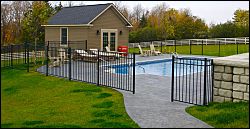 Patios are the perfect place for outdoor entertaining. Today's patios provide a focal point that connects a home to a garden and are important to a home's landscape. According to Better Homes and Gardens (July 2010), patios originated in Egypt as courtyards. Look around your yard, are there features in your landscape you want to complement? Materials for patios are varied and include:
Patios are the perfect place for outdoor entertaining. Today's patios provide a focal point that connects a home to a garden and are important to a home's landscape. According to Better Homes and Gardens (July 2010), patios originated in Egypt as courtyards. Look around your yard, are there features in your landscape you want to complement? Materials for patios are varied and include:
- Concrete. Concrete is eco-friendly and provides a flat, durable patio surface that requires a minimum of maintenance. Stamped concrete can produce the look of flagstone, bricks, pavers and other textures.
- Pavers. Pavers are made from materials such as natural stone, brick and concrete. They are a popular choice for patios because they inexpensive and can be easily installed. Pavers come in many styles, shapes and colors which resist fading and are easy to maintain. Pavers are also produced in a concrete flagstone design which provides the look of natural stone at a fraction of the cost.
- Flagstone. Flagstone is sedimentary rock cut or split into layers for paving patios or walkways. Many of us in central New York are familiar with flagstone because it is mined in New York and Pennsylvania. Typical colors of flagstone are blue, red and buff. Flagstone is extremely durable and does require annual care since it can darken due to sediment build up, algae and mold. Sediment and debris can be removed with a power washer to restore the stone to its luster. You may also have to re-set stones with sand if they loosen. Flagstone is more expensive that other patio materials and may be more expensive to install. If you plan to reside in your home for a long period of time, flagstone is a worthwhile investment.
- Terra-cotta tiles. Terra cotta tiles are ceramic tiles that were hand-molded for outdoor use in France hundreds of years ago. Terra cotta tiles can provide an elegant look to your patio. Ceramic tiles are durable and come in a variety of shapes and colors. They do become slippery when wet and are not a good choice around pool areas.
- Brick. Patio bricks come in varied sizes, colors and patterns. Bricks can be installed in a variety of patterns and are classic patio materials. Bricks can also be used for patio walls and garden edging.
- Wood blocks. Wood blocks are probably the least expensive material to use as a patio surface. Use only pressure treated lumber, redwood or cedar heartwood. Blocks can be sliced with a circular saw to create an even surface. Wood block patios and walkways are rustic and often used in woodland cabins and summer camps.
No matter which product you choose for your exterior renovation, remember one of the most important elements to making a patio last is proper base preparation including the type of base materials, amount of base materials, level and compaction of base materials and good drainage.
Patios require level ground. Patios integrate the beauty of a garden with the exterior of a home. Consider adding features like a fire pit, outdoor fireplace, a garden wall, plantings areas and a water fall to your patio design.


 Patios are the perfect place for outdoor entertaining
Patios are the perfect place for outdoor entertaining